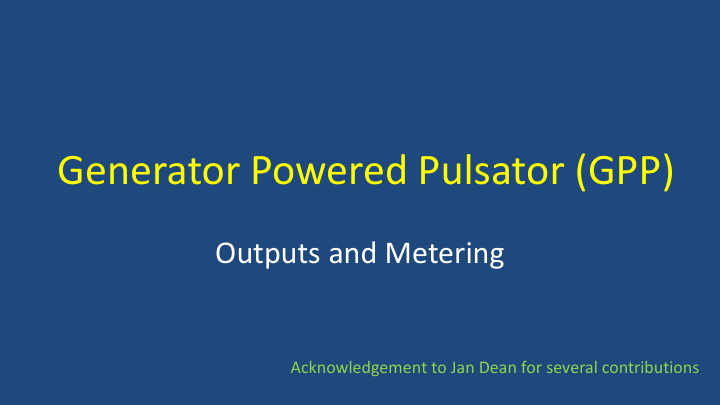



Generator Powered Pulsator (GPP) Outputs and Metering Acknowledgement to Jan Dean for several contributions
GPP Smith-Root, Inc. Note: peak reading digital voltmeter and ammeter (optional) Continuous voltage control? Frequency
How PDC is Generated Volts Volts Time Time
How PDC is Generated and Controlled Volts Volts Time Time
Smith-Root GPP Percent of Range Adjustment 10% 10 % of Range 1.2 1.0 0.8 0.6 0.4 0.2 0.0 0 90 180 270 360 450 540 630
Smith-Root GPP Percent of Range Adjustment 30% 30 % of Range 1.2 1.0 0.8 0.6 0.4 0.2 0.0 0 90 180 270 360 450 540 630
Smith-Root GPP Percent of Range Adjustment 50% 50 % of Range 1.2 1.0 0.8 0.6 0.4 0.2 0.0 0 90 180 270 360 450 540 630
Smith-Root GPP Percent of Range Adjustment 75% 75 % of Range 1.2 1.0 0.8 0.6 0.4 0.2 0.0 0 90 180 270 360 450 540 630
Smith-Root GPP Percent of Range Adjustment 100% 100 % of Range 1.2 1.0 0.8 0.6 0.4 0.2 0.0 0 90 180 270 360 450 540 630
Percent of Range (POR) Control 10 POR 20 POR 40 POR 60 POR 80 POR 100 POR
S-R GPP Pulse Width vs. Range Setting Pulse Width vs % Range GPP 7.5 Electrofisher 5 4 Pulse Width (ms) 3 2 1 0 0 20 40 60 80 100 GPP % Range
S-R GPP Voltage vs. Range Setting Peak Voltage vs % Range GPP 7.5 Electrofisher 120 110 100 Voltage (% Setting) 170 90 340 80 500 70 1000 60 50 40 0 20 40 60 80 100 120 GPP % Range
S-R GPP Duty Cycle vs. Range Setting Duty Cycle vs % Range GPP 7.5 Electrofisher 50 15 60 120 40 Duty Cycle (%) 30 20 10 0 0 20 40 60 80 100 GPP % Range
Which Frequency should you use? Consider optimum Duty Cycle (20 – 40%) Duty Cycle vs POR GPP 7.5, Three Frequencies 15 60 120 50 Duty Cycle (%) 40 30 20 10 0 0 20 40 60 80 100 Percent of Range Settings with a target duty cycle of 20 – 40%: 120 pps = 20 – 60 POR 60 pps = 60 – 100 POR
A Consideration About Metering Does the GPP ammeter measure Peak or Average current? Peak & GPP Current vs POR Adjustment GPP 7.5, 60 & 120 Hz Using the 60 pps, 60% of range Fluke 120 GPP 120 Fluke 60 GPP 60 settings, the peak voltage was 30 ~25 amps and the GPP ammeter 25 Current (Amps) reading was ~5 amps. Duty 20 cycle at 60 pps, 60 POR is about 15 20%. Thus, the average current 10 is about 20% of the peak. In 5 this case, 20% of 25 amps is 5 0 0 20 40 60 80 100 amps. Percent of Range Fluke 60 or 120 = scopemeter measured peak current under 60 pps or 120 pps GPP 60 or 120 = GPP ammeter displayed current under 60 pps or 120 pps
Summary • GPPs have interrelated controls, i.e., the POR controls peak voltage (and peak current and peak power) in an asymptotic fashion, it increases over 10-60 POR then begins to level off within 60-100 POR • This interrelatedness between voltage and duty cycle (two important fish- catching factors) leads to greater variation and hinders standardization • The operator does not have fine control over voltage and duty cycle, hindering the use of standardization tables • POR increases pulse width in a linear fashion • Changing frequency affects duty cycle (possibly why some agencies only use 120 pps with GPPs) • GPPs lack peak metering for current and have no voltage metering (to monitor peak voltage or current output, either must use external metering or install Smith-Root, Inc. metering)
Summary (continued) • Settings for general warmwater fish sampling: – set Frequency to 120 pps – set Percent of Range (POR) knob in a range of 40 – 60 – in very low (say ≤ 50 µS/cm) or in very high (say ≥ 800 µS/cm) conductivity, try Alternating Current (AC)
Optional Meter for GPPs
GPP Meter Display All the important attributes are displayed: peak volts, peak amps, and peak power plus frequency and duty cycle. However, you still have very little direct control of output.
Recommend
More recommend